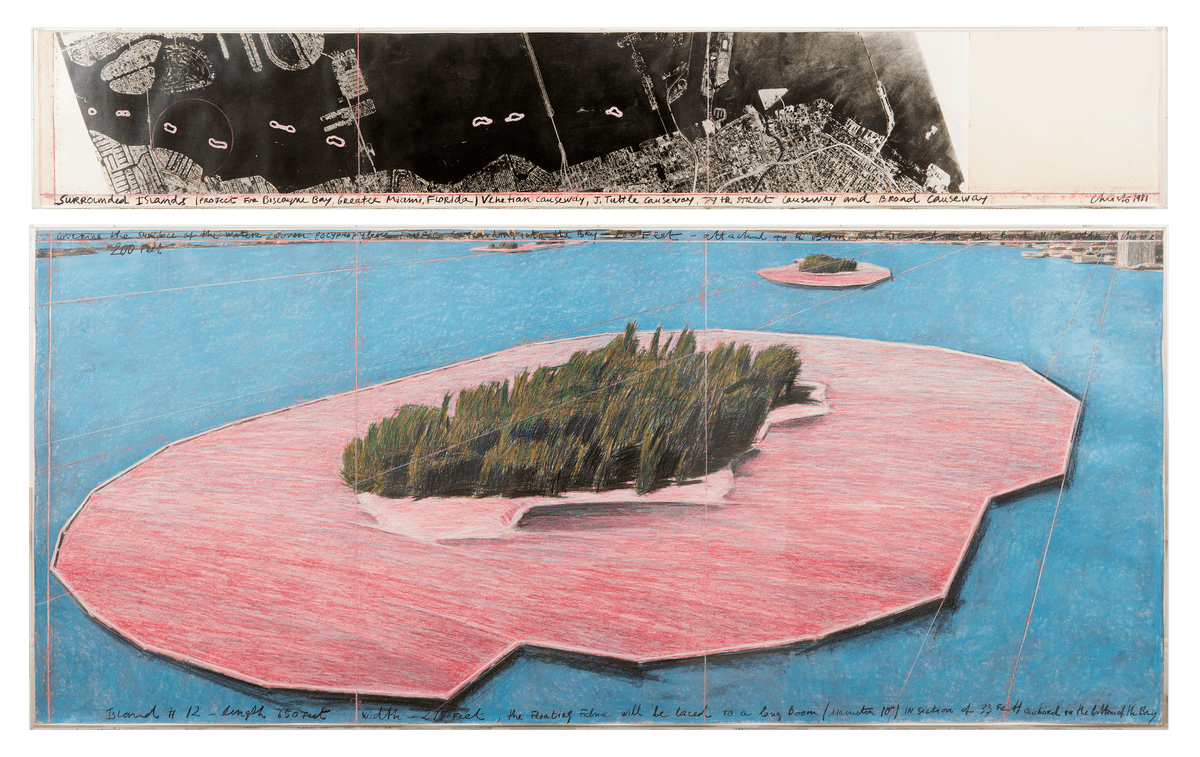Surrounded Islands (Project for Biscayne Bay)
On May 7, 1983, the installation of Surrounded Islands was completed in Biscayne Bay, between the city of Miami, North Miami, the Village of Miami Shores and Miami Beach. Eleven of the islands situated in the area of Bakers Haulover Cut, Broad Causeway, 79th Street Causeway, Julia Tuttle Causeway, and Venetian Causeway were surrounded with 603,870 square meters (6.5 million square feet) of floating pink woven polypropylene fabric covering the surface of the water and extending out 61 meters (200 feet) from each island into the bay. The fabric was sewn into 79 patterns to follow the contours of the eleven islands.
For two weeks, Surrounded Islands, spreading over 11.3 kilometers (7 miles), was seen, approached and enjoyed by the public, from the causeways, the land, the water and the air. The luminous pink colour of the shiny fabric was in harmony with the tropical vegetation of the uninhabited verdant islands, the light of the Miami sky and the colours of the shallow waters of Biscayne Bay.
Since April 1981, attorneys Joseph Z. Fleming, Joseph W. Landers, marine biologist Anitra Thorhaug, ornithologists Oscar Owre and Meri Cummings, mammal expert Daniel Odell, marine engineer John Michel, four consulting engineers, and builder-contractor, Ted Dougherty of A and H Builders, Inc. had been working on the preparation of the Surrounded Islands. The marine and land crews picked up debris from the eleven islands, putting refuse in bags and carting it away after they had removed some forty tons of varied garbage: refrigerator doors, tires, kitchen sinks, mattresses and an abandoned boat.
Permits were obtained from the following governmental agencies: The Governor of Florida and the Cabinet; the Dade County Commission; the Department of Environmental Regulation; the City of Miami Commission; the City of North Miami; the Village of Miami Shores; the U.S. Army Corps of Engineers; the Dade County Department of Environmental Resources Management.
The outer edge of the floating fabric was attached to a 30.5 centimetre (12 inch) diameter octagonal boom, in sections, of the same colour as the fabric. The boom was connected to the radial anchor lines which extended from the anchors at the island to the 610 specially made anchors, spaced at 15.2 metres (50 ft) intervals, 76.2 metres (250 ft) beyond the perimeter of each island, driven into the limestone at the bottom of the bay. Earth anchors were driven into the land, near the foot of the trees, to secure the inland edge of the fabric, covering the surface of the beach and disappearing under the vegetation. The floating rafts of fabric and booms, varying from 3.7 to 6.7 metres (12 to 22 ft) in width and from 122 to 183 metres (400 to 600 ft) in length were towed through the bay to each island. There were eleven islands, but on two occasions, two islands were surrounded together as one configuration.
As with Christo and Jeanne-Claude's previous art projects, Surrounded Islands was entirely financed by the artists, through the sale of preparatory drawings, collages, and early works. The artists did not accept sponsorship of any kind.
On May 4, 1983, out of a total work force of 430, the unfurling crew began to blossom the pink fabric. Surrounded Islands was tended day and night by 120 monitors in inflatable boats. Surrounded Islands was a work of art underlining the various elements and ways in which the people of Miami live, between land and water.
Surrounded Islands (Project for Biscayne Bay)
- Artist
- Christo and Jeanne-Claude (1935–2020) (1935–2009)
- Title
- Surrounded Islands (Project for Biscayne Bay)
- Medium
- Mixed media, collage on paper on two panels
- Date
- 1981
- Size
- Lower panel: 43 x 97 in : 109.2 x 246.4 cm
Upper panel: 28 x 97 in : 71.1 x 246.4 cm - Inscriptions
- Signed and dated on the lower right of the upper panel.
Extensively inscribed on both panels. - Provenance
- Acquired directly from the artist
Private collection - Reference
- AC22-66
- Download PDF
- Status
- No Longer Available
Available Artists
- Albers Anni
- Ancart Harold
- Andre Carl
- Avery Milton
- Baldessari John
- Barnes Ernie
- Calder Alexander
- Castellani Enrico
- Clough Prunella
- Crawford Brett
- Dadamaino
- de Tollenaere Saskia
- Dyson Julian
- Elsner Slawomir
- Freud Lucian
- Gadsby Eric
- Gander Ryan
- Guston Philip
- Haring Keith
- Hartung Hans
- Hayes David
- Held Al
- Hepworth Barbara
- Hill Anthony
- Hitchens Ivon
- Hockney David
- Hutchinson Norman Douglas
- Jenney Neil
- Katz Alex
- Kentridge William
- Knifer Julije
- Kusama Yayoi
- Le Parc Julio
- Leciejewski Edgar
- Léger Fernand
- Levine Chris
- Marchéllo
- Martin Kenneth
- Mavignier Almir da Silva
- Miller Harland
- Mitchell Joan
- Modé João
- Moore Henry
- Morellet François
- Nadelman Elie
- Nara Yoshitomo
- Nesbitt Lowell Blair
- Nicholson Ben
- O'Donoghue Hughie
- Pasmore Victor
- Perry Grayson
- Picasso Pablo
- Pickstone Sarah
- Prehistoric Objects
- Riley Bridget
- Ruscha Ed
- Sedgley Peter
- Serra Richard
- Shrigley David
- Smith Anj
- Smith Richard
- Soto Jesús Rafael
- Soulages Pierre
- Spencer Stanley
- Taller Popular de Serigrafía
- The Connor Brothers
- Vasarely Victor
- Vaughan Keith
- Whiteread Rachel
- Wood Jonas
